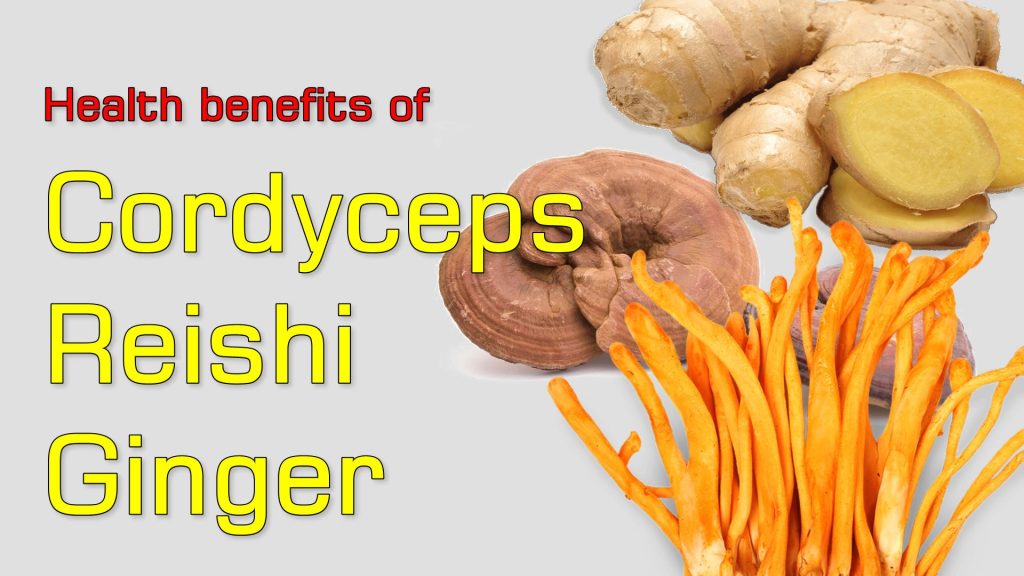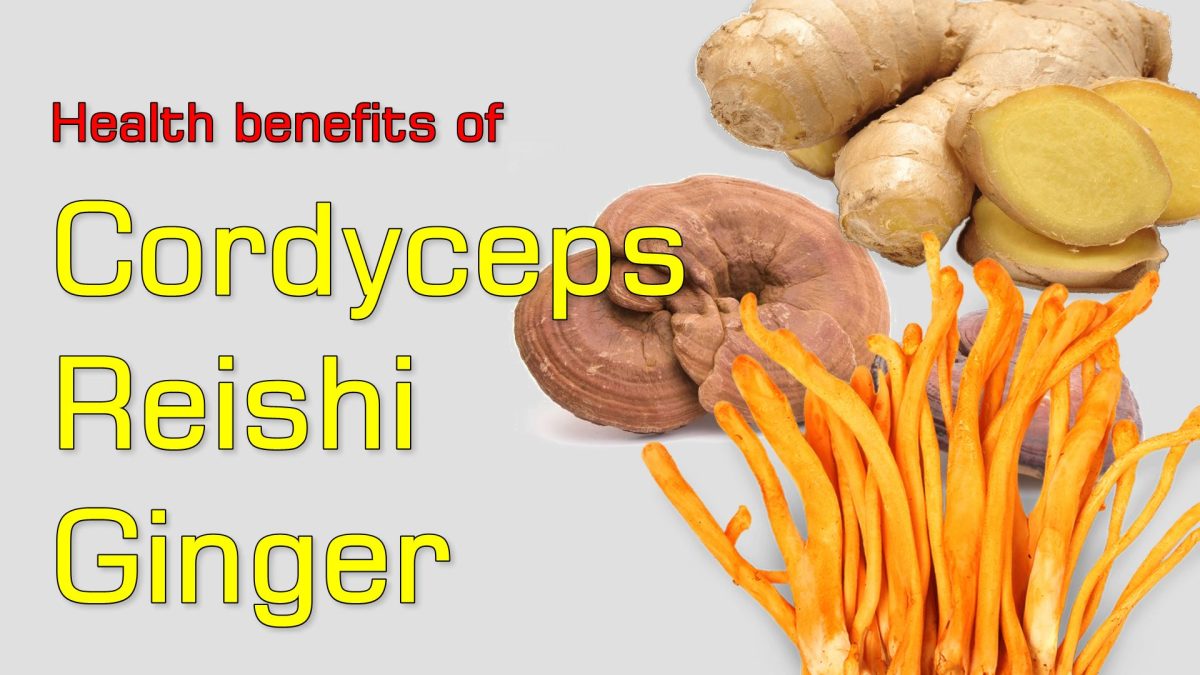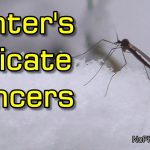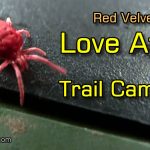
In this video I demonstrate how I make a tea from Cordyceps, Reishi and Ginger. Below is the transcript of the text on the science backed health benefits of each – Cordyceps, Reishi as well as Ginger. Links to the cited studies will be at the end of the post:
Cordiceps
Cordyceps is actually a parasitic fungus. It infects insects and destroys them from the inside by sprouting out through their body, usually a skull, like an alien. But as is apparent here, it can also be cultivated at home. No insects destined for brutal death needed for that. Just inoculated seeds.
In Traditional Chinese Medicine, Cordyceps has been used for centuries and is credited mostly with the ability to increase energy and enhance libido, but also a host of other health benefits.
A number of scientific studies have been carried out to analyze the properties and health effects of Cordyceps, but most have been done on animals or laboratory tissue. I’ll mention a few..
For example, a study published in the International Journal of Medicinal Mushrooms volume 18 found that taking Cordyceps prolonged the time that mice could swim, and increased the amount of glycogen in the liver and muscles, which has an anti-fatigue effect, and increases the use of oxygen and the elimination of lactic acid.
Cordyceps has also been shown to counteract the effects of oxidative stress, which is known to accelerate aging and promote the onset of disease. That’s according to a 2016 study published in Alternative Therapies in Health and Medicine. The study, which was done with human peripheral blood cells, concluded that supplementation with Cordyceps Sinensis, the equally potent brother of Cordyceps Militaris, results in reduction in DNA damage. As to why, the study postulates the scavenging properties of the fungus as well as its ability to stimulate DNA repair may be behind the effect.
Similarly, a 2015 study published in the International Journal of Molecular Medicine found that Cordyceps Sinensis extends the life of the fruit flies through an anti-oxidative stress pathway.
In tests done on mice, it was observed that those who had taken CS-4, a synthetic strain of Cordyceps Sinensis, lived several months longer than those in the control group, who ingested placebo. That’s according to a 2011 study published in the Federation of American Societies for Experimental Biology Journal.
CS-4 was also used in the study published in 2004 in the Chinese Journal of Integrative Medicine. The study tested the effects of the fungus on the exercise capacity of the healthy elderly people in a randomized, double-blind, placebo-controlled trial. The study found that after ingesting 3 grams of CS-4, the level of physical condition of the elderly participants increased by 7%.
A research published in the Indian Journal of History of Science analyzed Cordyceps Sinensis and concluded that Cordyceps can fight sexual dysfunctions and be a natural alternative to Viagra. The researchers called Cordyceps Sinensis a Himalayan aphrodisiac.
A 2009 study published in Phytotherapy Research subjected aged mice and castrated rats to water maze and avoidance tests and demonstrated that Cordyceps Sinensis can improve memory, promote sexual function and has an antiaging effect.
A study published in 2014 in Oriental Pharmacy and Experimental Medicine by the Korean scientists found that Cordyceps reduces proteins that increase inflammation, making the fungus kind of a natural anti-inflammatory drug.
According to another study, published in Phytotheraphy Research in 2012, Cordyceps Sinensis increases levels of adenosine, a natural compound that acts as a heart protector.
And that’s still far from it as far as health benefits of Cordyceps go. As explained in a study published in Oxidative Medicine and Cellular Longevity in 2016, Cordyceps Militaris maintained adequate blood sugar levels in mice. The scientists concluded:
Cordiceps Militaris exhibited the ability to reduce blood glucose, decrease blood lipids, reduce renal injury, and lower inflammatory factors through enhanced antioxidant expression and the attenuation of oxidative stress. Cordyceps militaris fruit body extract, a safe pharmaceutical agent, thus has great potential as a new treatment for diabetic patients, especially those with nephritis.
Nephritis is inflammation of the kidneys.
A study published in the Journal of Diabetes Research in 2015, corroborates the findings on the benefits of Cordyceps Militaris in the treatment of Type 2 Diabetes Mellitus, and in addition confirms improvements in triglycerides and bad cholesterol.
Additionally, a 2004 study on diabetic mice published in Life Sciences found that the fruiting bodies of the Cordyceps fungi helped keep blood sugar levels in a healthy range. The effects did not extend to the carcass of the insect the fungus parasited on.
Cancer fighting capabilities of the fungus have also been confirmed by science. Such as in the 2015 study published in the Journal of Microbiology titled “Anti-tumor effect of Cordyceps militaris in HCV-infected human hepatocarcinoma 7.5 cells“.
Likewise, a 2015 study published in the Swiss journal Molecules demonstrated the anti-tumor potential of Cordyceps Militaris by inhibiting the growth of human cancer cells, including lung, colon, skin and liver cancers.
A 2007 study on mice by the Japanese researchers published in Biological and Pharmaceutical Bulletin found that Cordyceps helps fight depression by increasing the levels of Adrenalin and Dopamine, however the fungus did not increase the levels of Serotonin.
Another 2007 study, this time published in the American Journal of Chinese Medicine concluded that supplementation with Cordyceps Militaris improves sperm quality and quantity, decreases sperm malformations and increases sperm survival in subfertile boars and may partly support the role of Cordyceps in sexual enhancement.
A 2003 study published in the World Journal of Gastroenterology demonstrated liver protecting effects of the fungus and concluded that “Cordyceps Sinensis is a cheap and widely available herb that is well tolerated and has been used for centuries in traditional Chinese medicine without any side effect reported. In this study, we demonstrated that, administered at the stage of chronic hepatitis, Cordyceps Sinensis could successfully inhibit hepatic fibrogenesis and retard the development of cirrhosis. Moreover, it can strikingly ameliorate the liver function.”
A review of 22 studies published in 2014 in the Cochrane Database of Systematic Reviews showed that Cordyceps supplements improve renal function in patients with chronic kidney disease, which is one of the most common complications of diabetes. However, researches noted that more conclusive results are still needed.
There is even a study published in 2004 in the Journal of Ethnopharmacology on topical use of Cordyceps. The study found that the fungus can reduce skin inflammation in mice, thanks to its anti-inflammatory and anti-nociceptive activities, as well as its antioxidant and anti-angiogenic activities. Anti-nociception is the process of dealing with noxious substances in the body, like irritants. Anti-angiogenesis is the process of starving tumors by stopping them from developing new blood supply vessels.
A 2011 study on Cordyceps as an Herbal Drug published in Herbal Medicine: Biomolecular and Clinical Aspects. 2nd edition, was important for me, because aside from concluding that Cordyceps exhibits antitumor, antifatigue, immunomodulatory, antioxidant, hypoglycemic, sexual and reproductive function enhancing, as well as the kidney and liver protecting bioactivities, the study also notes that the cultured mycelia of Cordyceps, which is what I have here, are as effective as those found in natural Cordyceps.
Reishi
Reishi also has long and established history of use in the Traditional Chinese Medicine. Unlike Cordyceps, which is soft and chewable and thus edible after being cooked, Reishi is rigid and pretty much impossible to chew. I would liken the consistency to a cork, and have you ever tried chewing a cork? That’s what trying to eat a Reishi would be like. Even cutting the Reishi requires a very sharp knife and some force.
So because its fruiting bodies can’t be eaten, in order to enjoy the health benefits of Reishi, the active ingredients must be extracted either by way of boiling the mushroom in hot water, or by soaking it in alcohol for a couple of weeks to make a tincture. I use both techniques, often in combination, as each is able to extract different medicinal qualities from the fungus.
My research has lead me to the understanding that in order to thoroughly extract the water soluble compounds of Reishi, the fruiting body should be slowly simmered for an extended period of time, preferably more than 20 minutes. Merely steeping the fungus in hot water like a tea bag will leave a lot of the medicinal compounds still trapped in the mushroom.
But you also don’t want them to readily evaporate, so the way to do it is by bringing the water to a rolling boil, and then turning the heat down to maintain just a gentle boil for a number of minutes. Cutting the mushroom up into small pieces would increase the surface area of the mushroom, allowing the water to maximize the extraction effect.
Drying the fruiting bodies and then pulverizing them into a powder in a blender is an option, but in my opinion, the health benefits would be diminished if the mushroom is consumed this way. Unless of course you then boil the powder for several minutes, or macerate it for a few days in alcohol.
Plus of course there is this fact that the cell walls of fungi are made of a polisaccharide called chitin, and the human gut has a very low activity of the enzyme chatinase, which is capable of breaking down chitin. So without first exposing fungus to heat or alcohol, our bodies wouldn’t be able to break open fungal cells well enough to access the nutrients inside.
Aside from Chitin, which is to mushrooms what cellulose is to plants, another notable type of polisaccharides found in mushrooms are beta-glucans. In a scientific paper titled “Immunomodulatory effects of mushroom β-glucans” published in Woodhead Publishing Series in Food Science, Technology and Nutrition 2013, it is stated that:
In controlled human trials, β-glucan intake stimulated the immune system in the blood of healthy adults, dampened the allergic response to a respiratory inflammatory agent and improved survival in cancer patients.
While beta-glucans can be also found in whole grains, cereals, oats and seaweed, according to a study published in Evidence-Based Complementary and Alternative Medicine in 2014, compared to beta-glucans from other sources, the structural difference, chemical viabilities including molecular weight and water solubility made the beta-glucans from mushrooms more bioavailable and favorable for adjunct therapeutic applications.
A 2013 scientific paper published in the International Journal of Medicinal Mushrooms concluded that the bioactive components found in the Ganoderma Lucidum, which is the Latin name of the Reishi mushroom, have numerous health properties to treat disease conditions such as liver dysfunction, chronic hepatitis, kidney inflammation, hypertension, excess fat in blood, arthritis, physical and mental exhaustion, insomnia, bronchitis, asthma, gastric ulcers, atherosclerosis, low white blood cell count, diabetes, anorexia, and cancer. The paper notes that in spite of the voluminous scientific literature on the health benefits of Ganoderma Lucidum, the mushroom is used mostly as an immune enhancer and a health supplement, not therapeutically.
A 2003 study published in Immunological Investigations found that Reishi stimulates the growth of natural killer cells, which have the ability to combat cancer and infections in the body. The study concluded that the polysaccharides fractions extracted from Ganoderma lucidum enhanced the immune responses in patients with advanced-stage cancer.
Similarly, a 2001 study published in the Journal of Bioscience and Bioengineering found that both water soluble as well as water insoluble extracts from the culture broth of Ganoderma Lucidum were very effective in inhibiting the growth of several human cancer cell lines.
In another study, published in 2010 in the Hiroshima Journal of Medical Sciences, it was found that a water soluble extract from Ganoderma Lucidum reduced the size and number of tumors in the large intestine of colorectal cancer patients.
A 2014 study published in Molecules, which was done on rats, showed that Reishi can effectively combat hypertension and showed that not a single compound, but rather an aggregate of active compounds acting together helped to achieve the significant decrease in blood pressure.
A 2013 study published in BCM Complementary Medicine and Therapies tested the effects of Reishi on rats subjected to stress and fear conditioning. The study concluded that the Reishi had anti-depressant and anti-anxiety effects.
A 2012 study published in Experimental and Toxicologic Pathology done on rats showed that Reishi may protect hippocampus in the brain and thus may be beneficial when dealing with neurodegenerative disorders, such as Alzheimer’s Disease.
A 2013 study published in the International Journal of Medicinal Mushrooms studied the effects of Reishi on rats with convulsions induced by a seaweed extract. The study found that Ganoderma Lucidum inhibited convulsions, reduced the degeneration in the hippocampal regions, and had other protective effects on the brain.
A 2012 study published in Evidence Based Complementary and Alternative Medicine found that Reishi had beneficial effects on cancer-related fatigue, overall well-being and quality of life in breast cancer patients undergoing endocrine therapy. The patients taking Ganoderma Lucidum did not experience any significant adverse effects.
A somewhat ironic study was published in 2013 in the International Journal of Medicinal Mushrooms. The study tested the effects of the Reishi on liver health and found that Ganoderma Lucidum exhibited liver protective effects on acute liver injury.
The ironic part was that in order to induce liver damage to the studied mice, the scientists fed the mice an extract from Amanita Exitialis, a deadly poisonous mushroom known as the Chinese Destroying Angel.
One mushroom caused liver damage, while the other protected the liver from the damage. Mycology is truly fascinating, but it comes to show how important it is to get to know your mushrooms if you decide to go foraging. Right mushroom can save your life. Wrong mushroom can destroy it.
All Destroying Angels are deadly poisonous, but the species slightly differ from continent to continent. Here in Europe, it’s Amanita Virosa. In Western North America it’s Amanita Bisporigera, while in Eastern North America it’s Amanita Ocreata.
Destroying Angel, along with its genus cousin Amanita Phalloides, commonly known as the Death Cap, as well as some non Amanita deadly poisonous mushrooms like Galerina Marginata, commonly known as the Funeral Bell, should be well familiar to everyone even remotely considering a trip to the woods to pick up mushrooms.
Back to Reishi. The inclusion of the fungus as one of the superior tonics in Shennong Ben Cao Jing, is the testament to more than 2,000 years of its medicinal use. Shennong Ben Cao Jing dates back to 206 BC and is considered the most famous of all Chinese materia medicas.
Superior tonics of the time were believed to prolong life, prevent aging, boost qi, improve eyesight, strengthen bones and muscles. and generally benefit in healing of all ailments.
Chinese Royalty referred to Reishi as the fungus of immortality and until not too long ago, due to its rarity and the difficulty to access places where it grew, the consumption of Ganoderma Lucidum was reserved for the upper class of society.
Aside from the already mentioned beta-glucans, another significantly bioactive compound of the Reishi are Triterpenoids. According to a review paper published in 2019 in Biomedical Dermatology, Ganoderma lucidum also contains a variety of other active ingredients, such as nucleosides, sterols, alkaloids, polypeptides, fatty acids, steroids, and inorganic elements, all of which work in unison to provide the scientifically proven anticancer, anti-inflammatory, hepatoprotective, hypoglycemic, anti-aging, as well as skin barrier-repairing and skin pigmentation reducing activity.
But of all the active compounds in Reishi, it is beta-glucans and triterpenoids that are the primary heavy hitters. And because Triterpenoids are bitter to the taste, Reishi being rich in the chemical, is naturally bitter. That bitterness passes on to the tea and makes the tea quite bitter, but that’s how you know your tea is rich in Triterpenoids.
In contrast, Cordyceps has a fairly mild flavor that’s easy on most taste buds, but whereas Reishi is quite bitter, I boost the tea with a touch of Ginger, which adds zestiness to the concoction and makes the bitterness of Reishi less pronounced and more easily lost in the slew of flavors. Plus of course, Ginger adds additional health benefits to the already healthy tea.
Ginger
Ginger (Zingiber Officinale) is a familiar taste to many of us and it’s as refreshing as it is soothing, as biting as it is warm, somewhat pungent but also slightly sweet, and it’s flavorful but pairs well with just about any other flavor.
Whereas laying ones hands on Cordyceps or Reishi can require some extra legwork, Ginger tends to be easy to come by so truly – why not spice up your tea with its bursting and attractive flavor.
But ginger is far from just flavor enhancer. For example, ginger possesses multiple biological activities, including antioxidant, anti-inflammatory, antimicrobial, anticancer, neuroprotective, cardiovascular protective, respiratory protective, antiobesity, antidiabetic, antinausea, and antiemetic activities. Antiemetic means it helps avoid vomiting. That’s per a review paper published in 2019 in a scientific journal Foods.
A different review paper, also published in 2019 in Food, Science and Nutrition, notes that anti‐inflammatory, antioxidant, antitumor, and antiulcer effects of ginger have been proven in many scientific studies.
Yet another review paper of Ginger’s anti-inflammatory properties, published in 2013 in the International Journal of Preventative Medicine, concluded that Ginger can reduce muscle pain after intense physical activity, and its functional ingredients like gingerols, shogaol, and paradols can prevent various cancers, improve cardiovascular disorders, diabetes mellitus, and gastrointestinal health.
Similarly, a 2010 study published in the Journal of Pain also demonstrated that consumption of raw and heat-treated ginger resulted in moderate-to-large reductions in muscle pain following exercise-induced muscle injury.
All in all, the combination of the two medicinal mushrooms along with ginger make for a refreshing yet health promoting beverage. In this preparation, I used ginger bought from a lady who grew it herself, and both mushrooms were grown by me from inoculated seeds I bought from a reputable source in the European Union.
I also grow Lion’s Mane (Hericium Erinaceus) on hardwood logs, but I don’t make teas from Lion’s Mane. I cook the fungus and eat it as a meal.
Disclaimer
As a brief disclaimer I will remind you that I am not an expert on anything, so if you need an expert advice, find an expert. I share the information in good faith that you will find it helpful, but all of it is either my opinion, or is based on information from the third parties readily available on the internet.
I am not a doctor, a lawyer, a psychiatrist or your mother. I cannot give you medical advice or diagnosis, and as such, nothing contained in this video should be construed as such advice or diagnosis.
The information in this video is provided as an information resource only, and does not substitute for professional medical advice. If you seek medical advice, diagnoses, or treatment, I advise you to consult a medical professional or healthcare provider.
I am not liable for risks or issues associated with using or acting upon the information in this video.
YouTube video:
Odysee video:
3Speak video:
Cited Sources:
https://www.dl.begellhouse.com/journals/708ae68d64b17c52,57162b26264a3b98,4ad6a16757705f93.html
https://pubmed.ncbi.nlm.nih.gov/27433838/
https://www.ncbi.nlm.nih.gov/pmc/articles/PMC4564082/
https://faseb.onlinelibrary.wiley.com/doi/abs/10.1096/fasebj.25.1_supplement.599.1
https://link.springer.com/article/10.1007/BF02836405
https://www.insa.nic.in/writereaddata/UpLoadedFiles/IJHS/Vol45_2_3_AKPanda.pdf
https://pubmed.ncbi.nlm.nih.gov/18803231/
https://link.springer.com/article/10.1007/s13596-014-0173-3
https://onlinelibrary.wiley.com/doi/abs/10.1002/ptr.4899
https://www.hindawi.com/journals/omcl/2016/9685257/
https://www.hindawi.com/journals/jdr/2015/723190/
https://pubmed.ncbi.nlm.nih.gov/15050427/
https://link.springer.com/article/10.1007%2Fs12275-015-5198-x
https://pubmed.ncbi.nlm.nih.gov/26263965/
https://pubmed.ncbi.nlm.nih.gov/17827735/
https://www.worldscientific.com/doi/abs/10.1142/S0192415X07005120
https://www.ncbi.nlm.nih.gov/pmc/articles/PMC4621576/
https://pubmed.ncbi.nlm.nih.gov/25519252/
https://www.sciencedirect.com/science/article/abs/pii/S0378874104005148
https://www.ncbi.nlm.nih.gov/books/NBK92758/
https://www.sciencedirect.com/science/article/pii/B9780857090379500163
https://www.ncbi.nlm.nih.gov/pmc/articles/PMC3995106/
https://pubmed.ncbi.nlm.nih.gov/23557365/
https://pubmed.ncbi.nlm.nih.gov/12916709/
https://pubmed.ncbi.nlm.nih.gov/16233144/
https://pubmed.ncbi.nlm.nih.gov/20518254/
https://www.mdpi.com/1420-3049/19/9/13473
https://www.ncbi.nlm.nih.gov/pmc/articles/PMC3879659/
https://www.sciencedirect.com/science/article/abs/pii/S0940299310002332
https://pubmed.ncbi.nlm.nih.gov/24266379/
https://www.ncbi.nlm.nih.gov/pmc/articles/PMC3236089/
https://pubmed.ncbi.nlm.nih.gov/23796220/
https://en.wikipedia.org/wiki/Shennong_Ben_Cao_Jing
https://biomeddermatol.biomedcentral.com/articles/10.1186/s41702-019-0044-0
https://www.mdpi.com/2304-8158/8/6/185/htm
https://www.ncbi.nlm.nih.gov/pmc/articles/PMC6341159/
https://www.ncbi.nlm.nih.gov/pmc/articles/PMC3665023/
https://pubmed.ncbi.nlm.nih.gov/20418184/






Not the usual but totally informative.
Hey there, I think you chose the right path to do this =)
Thank you 🙂
How would someone with no survival knowledge and limited experience learn the basics of survivalism?
With hands on. Put on some hiking boots and head into nature. Even if you live in a big city, there’s bound to be a forested area within an hour’s drive from where you live. If you have a partner – great. Have an outing as a couple. If you are alone, go at it alone. Take a walk first. Get the feel of the forest. Hear the sounds, breathe the clean air, observe how nature vibes. Watch the birds, the leaves on the trees, watch how they swing freely with wind, see if you can spot an animal track, maybe even animal footprints, and whatever plant catches your eye, take pictures of it and when you get home, see if you can look up what it is. The detective work can get really rewarding if you persevere and stay at it until you’ve identified a wild plant.
Even the greatest survivalist started from zero. Everybody was at a stage when they knew nothing. But if you keep taking baby steps, eventually you pick up a lot and get better at it. Once you feel up for it, roll up a tent and try to stay in the wild overnight. Collect firewood for the fire and start it any way you can. Then keep it going.
You can learn a lot by watching videos of other people, but nothing beats hands on experience and the feeling you get when you figure something out on your own. A shortcut by picking it up from someone else’s advice would get you there faster, but the reward with inner satisfaction when you figure something out for yourself is priceless and totally worth it.
If your question was indeed sincere, I’d be happy to speak with you more on this topic. Either way, I wish you a lot of fun growing as a self-reliant person and remember, much as is said in the Bible (Luke 17:20-21):
You already are what you need to be. You just need to discover it. Simply observing is not enough. You need to get your “hands dirty” so to speak.
I’ll try that. Went for a walk, my city has a forest within it, and identified a tree (plants are all buried under snow). Found lots of animal tracks because their footprints were imprinted in the snow.
Usually having some pre-knowledge helps, even if you need to put it into practice to get the subtleties. Enough to give you the tools to figure something out. Getting complete. accurate steps and following them is worse than knowing nothing at all. Ruining things for yourself.
True dat. It’s winter where I live too, so identifying plant life is not gonna happen. But as you noted, there are other things to observe and learn from.
I guess the best answer will be somewhere in the middle. I am a self taught guitar player. I started learning without a teacher in the 1980’s, before there was the internet. At least where I lived it was not readily available. I had to discover everything on my own without any guidance. I remember the excitement of discovering the two-hand tapping technique on my own. Of course soon enough I realized that this is commonly used by more skilled guitar players and had I had a teacher, I would have been taught that without the long road of self discovery. But the amazing feeling of discovering it on my own without a shortcut has stayed with me to this day.
So you are absolutely right that having some pre-knowledge helps. It absolutely does. Especially if you feel like it may be useful to have the skills asap. The long and painful trial-and-error path takes some time. The joy of discovering it without a shortcut be damned when the need comes a knocking.
I too have watched a bunch of videos by other bushmen to pick up a thing or two, because let’s be honest – the information is readily available so why take the long and windy road? But the details and fine tunes will not get polished until you got your hands in the dirt yourself. That’s how you start realizing the little subtleties that escaped your attention while pre-watching a video.
I have not yet gotten to sharing videos with tips on wilderness survival, but it’s something I plan to get into.